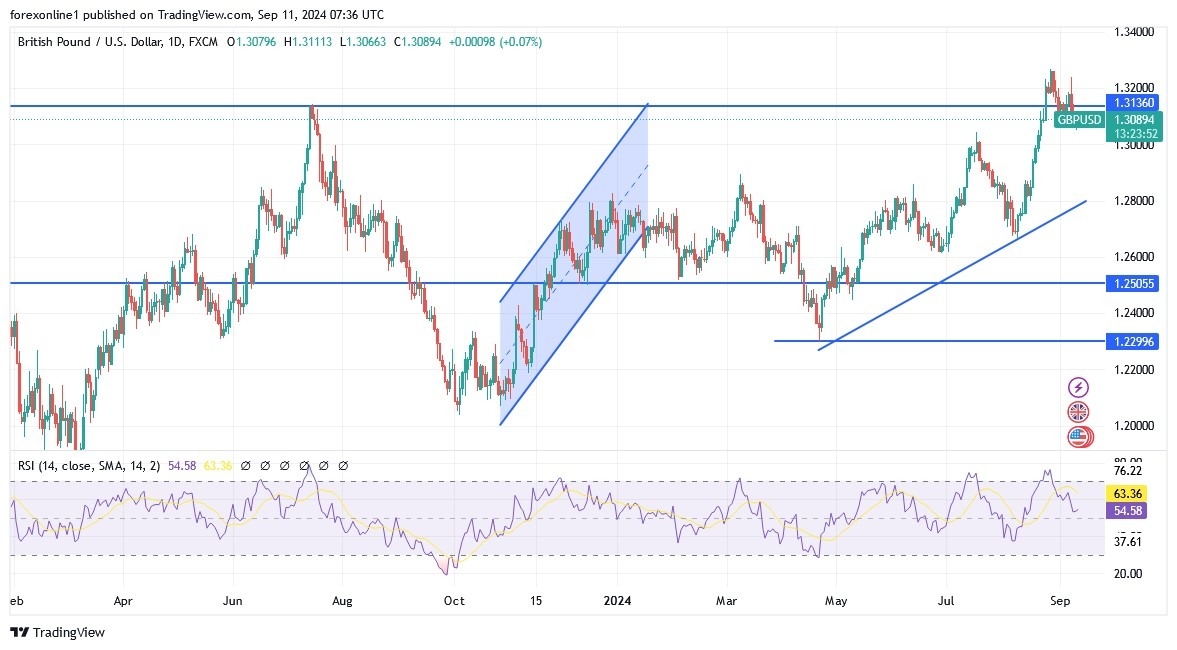- The pound sterling remained relatively unchanged at $1.3080 as traders digest new economic data and monetary policy outlook.
- According to the official announcement, the UK GDP stalled for the second consecutive month in July, missing expectations of a 0.2% increase, and industrial production contracted unexpectedly by -0.8%.
- Wage growth also slowed to 5.1%, its lowest level in about two years, while private sector wage growth, the measure the Bank of England monitors, slowed to its lowest level in 2022 at 4.9%.

On the other hand, the country’s unemployment rate fell to 4.1% and the UK economy added 265,000 jobs, well above expectations of 265,000. Furthermore, the Bank of England cut interest rates in August but has taken a cautious approach to further rate cuts. Investors are expecting a fall in borrowing costs in November, with a further cut possible in December.
Prior to that, the pound sterling rose against the euro and the dollar on the back of strong job gains. According to reliable trading platforms, the pound sterling has risen against the US dollar and the euro and other G10 currencies following the release of UK jobs and wages data, which showed no significant deterioration in the Labor market. According to trades, the pound sterling rose to 1.1847 against the euro in the minutes following the National Statistics Office's announcement that the UK added 265,000 jobs in the three months to July, beating estimates by 123,000 jobs, which is the largest increase since May 2022. Also, the unemployment rate fell to 4.1% from 4.2%. Wage data was in line with expectations at 5.1%, but when bonuses were included in the measure, the reading of 4.0% was slightly below estimates of 4.1%.
According to forex trades, the GBP/USD rose to 1.3082 but remains under pressure in the end due to the broader rise in the US dollar that began in September. Clearly, the jobs and wages report confirm the strength of the UK economy and confirms market expectations that the Bank of England will leave interest rates unchanged next week. In this regard, Kenneth Brooks, an analyst at Société Générale, said: "Is the Labor market slackening? Employment has now risen over the past three months, with the three-month moving average rising from -157,000 jobs in April to +127,000 jobs in July, a shift in trend that would give the Bank of England hawks ammunition to oppose faster rate cuts."
Overall, economists expect the next rate cut to come in either October or November: "The bigger picture is that the bank will move slowly due to high wage levels that will help push inflation higher in the coming months."
Meanwhile, the data indicates stubbornly high underlying inflationary pressures, and steady wage growth - which poses upside risks to inflation in the medium term - is likely to keep rate cuts at a more gradual pace than the European Central Bank and the Federal Reserve, even into next year. As a result, "We expect sterling to outperform the dollar and the euro on our forecast horizon."
Michael Brown, chief analyst at Pepperstone, says a September rate cut is still out of the question after these days. He explains that quarterly 25 basis point cuts remain his base case, with these cuts likely to coincide with the bank's updated economic forecasts, thus leaving the November meeting on the table for the next, and likely last, cut this year. Such expectations, of course, are somewhat tighter than those expected by the European Central Bank and the FOMC, where a 50-basis point rate cut in September remains a possibility. Consequently, this divergence could help support sterling in the medium term, against both the euro and the US dollar.
In general, market prices show that investors expect less than two rate cuts before the end of the year, which is confirmed by the nature of the coming days. This puts UK bond yields and the GBP at a relative advantage compared to the USD and the EUR, barring a correction in risk assets and another volatility shock.
Top Forex Brokers
Technical forecasts for the GBP/USD pair today:
Based on the performance on the daily chart attached, the GBP/USD price is still trending downwards and the bears' control over the trend will strengthen if the currency pair moves towards the support levels of 1.3000, 1.2940 and 1.2880 respectively. At the latter level, the technical indicators will move towards strong oversold levels. In contrast, and over the same period, the bulls' control over the trend will return if the currency pair stabilizes above the resistance of 1.3200 again. Decisively, today's US inflation figures will be the last to determine the path of the currency pair in the coming days.
Ready to trade our GBP/USD Forex forecast? Here’s some of the best forex broker UK reviews to check out.
